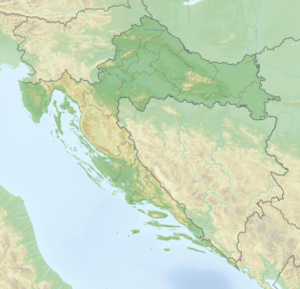Sveti Juraj (Srbani)
| Sveti Juraj | ||
|---|---|---|
|
Castle ruins, August 2015 |
||
| Alternative name (s): | Kaštelir Sv. Jurja (German Saint George ) Kaštelir Santi Quaranta (German of the Forty Saints ) |
|
| Creation time : | early middle ages | |
| Castle type : | Hilltop castle | |
| Conservation status: | Wall remnants, rubble | |
| Standing position : | clergy | |
| Construction: | Mostly stocked quarry stone masonry | |
| Place: | Srbani , Nova Vas village, Brtonigla municipality | |
| Geographical location | 45 ° 20 '13.9 " N , 13 ° 37' 56.6" E | |
| Height: | 41 m | |
|
|
||
Sveti Juraj , Kaštelir Sv. Jurja (German Sankt Georg , also of the Forty Saints , Santi Quaranta ) is the ruin of a prehistoric castle near the village of Srbani , Općina Brtonigla in the Croatian part of Istria .
location
The ruins of the medieval castle are located on a rocky outcrop that rises north over the valley and the mouth of the Mirna River .
Today it can only be reached via a footpath and for the most part it is overgrown and left to decay. One of the boards nearby describing the karst , its vegetation and the nearby Špilja Serbani ( Pećina Ispod Sela Srbani ) grotto refers to the ruin.
description
The most recognizable feature of the ruin is the wall that still exists. It stands in a west-east direction and is about 40 m long and about 5 to 6 m high. Because of the steep terrain, the ground is about 2 m lower on the northern side. From this it can be concluded that this is part of the northern outer wall of the earlier castle. In the middle it is about a meter thick.
The ruin of the church is about 50 m further east. Above all, the western outer wall with the bell gable was preserved from her. Between 2015 and 2019, the outer walls with the apse were partially reconstructed.
History of the castle

A castellier, which was inhabited at least temporarily, already existed in prehistoric times, as can be seen from visible traces such as a dark cultivated soil interspersed with ceramic fragments and step-shaped workings that are particularly evident at the tip of the ledge. A section wall covered with soil, which bordered the castellier to the east, can also be seen in the undergrowth. A grave lined with stone slabs, which cannot be classified due to robbery, is located near the ruin.
The later castle of Sv. Juraj is a fortified complex with a church of the same name that was in use from the early Middle Ages to the second half of the 14th century.
In 992 Alderus de Castro was the lord of the castle. In 1230 Viadotto and Fabiano are named as owners. In 1260, the Patriarch of Aquileia , Gregorio of Montelongo (1251–1269) of Almerico acquired sqm. Vidotto three quarters and by Bianchino, son of the late Ossalacco from Momjan , the other quarter of the castle. He had it restored, expanded and made into a base for the supervision of his Istrian possessions. After the attack by the Republic of Venice in 1291 and the Republic of Genoa in 1354, the castle lost its political and military strategic importance.
She often changed hands. The patriarch sold them to Alberto Bratti from Koper . In 1420 the Serenissima ceded it to Grožnjan . In 1545 the castle and its feudal estate were acquired by Alessandro Soranzo for 1627 ducats with the obligation to spend one fortieth of the proceeds on the maintenance of the Church of St. George and St. Michael . Later ownership passed to Bartolomeo and Bertuccio Manzini from Buje , who remained owners until the middle of the 19th century.
church
The Romanesque church, of which remnants of the northern outer walls and the facade with a bell gable are still preserved, dates from the 12th century. It served as a parish church until 1820, when a plague epidemic raged in the area in 1476. In 1622, the Bishop of Novigrad Eusebio Caimo ordered the church to be plastered and whitewashed and a cross to be erected on its top so that it could be seen from afar by sailors.
Individual evidence
- ^ Hans-Dieter Kaspar, Elke Kaspar: Istria in prehistoric times . BoD , Schweinfurt 2014, ISBN 978-3-7322-9616-3 ( limited preview in the Google book search).
- ↑ Maja Čuka: Tipološka Obrada odabranih olomaka prapovijesne ceramics iz Pećine ispod sela Srbani - A typological analysis of selected prehistoric pottery fragments from Pećina ispod sela Srbani. (PDF; 1.57 MB;) In: Histria archaeol. 40/2009, pp. 13-44. December 2, 2010, p. 2 , accessed September 9, 2015 .


